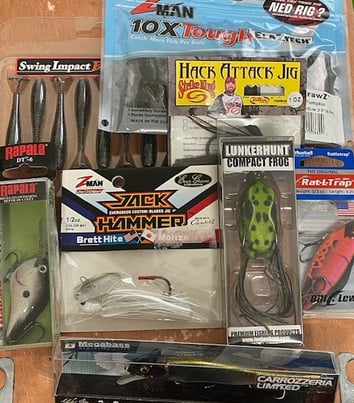Selecting a Fishing Lure when Bass Fishing - Things to think about when choosing a Lure.
Lures that catch bass are typically selected based on their effectiveness in attracting both largemouth and smallmouth bass. This is crucial because different conditions can alter which lure works best. When Bass Fishing something that works one day may not work the next.
2/11/20253 min read


Understanding the characteristics of fishing lures can greatly enhance an angler's success. Characteristics such as the movement, color, and size of the lure play significant roles in their appeal to bass. Anglers who fine-tune their strategies to master these aspects significantly increase their chances of victory in the competitive bass fishing scene.
The presentation of the lure is as important as the lure itself. Skillful anglers know how to adjust their techniques to fit the water conditions and the behavior of the fish. They aim to make the lure look as natural as possible to entice bass to bite, capturing the prize with their expert approach.
Key Takeaways
Lure choice is crucial for bass tournament success.
Winning lures have specific appealing characteristics.
Lure presentation techniques are essential for attracting bass.
Lures
Selecting the right lures can make a significant difference in bass tournaments. Key factors include the design and action of the lure, the importance of color for visibility, and choosing lure types based on seasonal patterns.
Design and Action
The design and action of a lure are crucial for attracting bass. Lures come in various shapes and sizes, each designed to mimic the movement of prey. Crankbaits, for example, are engineered to dive quickly and wobble through the water. Spinnerbaits use metal blades to reflect light and create vibrations. Both designs aim to spark the bass's instinctual response to chase and attack.
The action should match the preference of the bass under specific conditions. Fast, erratic movements often trigger strikes in warm water, while slower, subtle actions are effective in cooler waters. Matching the lure's action to the current environment can significantly increase fishing success.
Color Selection and Visibility
Color is vital for lure selection. Clear water conditions often require natural colors, like greens and browns, which imitate live prey. In murkier water, bright colors such as chartreuse and orange become important. These colors stand out and catch the bass's attention when visibility is low.
Anglers must also consider light conditions. On sunny days, more subtle colors may be effective, while cloudy or overcast conditions can favor brighter tones. Understanding how different colors behave in varying light and water conditions helps anglers choose the most visible and appealing lure.
Seasonal Lure Choices
Different seasons demand different lure choices due to changes in bass behavior and environmental conditions. In spring, when bass are spawning, jigs and soft plastics that mimic smaller prey are popular, as they tend to stay near nests. During summer, topwater lures are effective in warmer waters where bass feed more aggressively.
In fall, crankbaits that resemble baitfish are often successful, as bass prepare for winter. Finally, in winter, slow-moving lures such as jigs and spinnerbaits become effective, as bass's metabolism slows down and they become less active. Selecting season-appropriate lures maximizes the chances of catching tournament-winning bass.
Strategies for Lure Presentation
Presenting lures effectively in bass tournaments requires skill and precision. Key strategies include using specific casting techniques, adjusting retrieval speed and rhythm, and considering depth and cover.
Casting Techniques
Effective casting can make a significant difference. Anglers often use flipping and pitching for precise lure placement in tight spots. These techniques help in avoiding obstacles like branches or debris.
Sidearm casting is useful for low-profile approaches. It keeps the lure closer to the water, reducing splash and potential spooking of fish. Overhand casting, meanwhile, is ideal for distance, especially in open water areas.
Precision is critical. Accurate casting increases the chances of landing lures near structures where bass often hide. Practicing different casting styles is essential for adapting to various fishing conditions.
Retrieval Speed and Rhythm
Varying retrieval speed is crucial in enticing bass. Fast retrievals can provoke reaction strikes, especially when using lures like crankbaits. Slow and steady retrievals often work well with soft baits, allowing the lure to mimic natural movements.
Experimenting with pauses during retrieval can also be effective. Pauses give the lure a lifelike appearance, resembling injured prey. This unexpected stop-and-go action can lure bass into striking.
Rhythm consistency also plays a role. Experienced anglers understand how rhythm can affect lure action, making it vital to match the rhythm to the lure type and bass activity level.
Depth and Cover Considerations
Understanding depth preferences and cover features can enhance lure presentation. Bass frequently stay near structures like weeds, rocks, or submerged trees. Casting near these structures increases the chances of attracting bass.
It's vital to adjust the lure's depth. Using weighted lures or adjusting bait weight can help in reaching the desired depth. This is particularly important when bass are holding deeper or if the weather is influencing their location.
Targeting specific depths around cover ensures the lure remains in the strike zone longer. This approach often leads to better results in tournaments, as it increases the chance of catching bass that are actively feeding.
Final thoughts
Don't get discouraged when a lure or technique does not work. Have the willingness to change. Nothing feels better then when you figure them out.
Most successful days fishing you will be using multiple lures. As the day and conditions change so you lure selection may have to change.
© 2025. All rights reserved.
